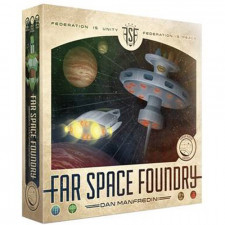Far Space Foundry Review
on May 17, 2016
Making the vastness of space peaceful for our kind takes a lot of gear, and Terra Nova Games’ Far Space Foundry gives 1-4 entrepreneurs the chance to supply it to those who boldly go. While it’s not quite an omnivore, it brings a big slab of meat to the table, almost overpowering the victory-point salad and delivering a tight, challenging experience.
Eurogames typically strive for the trifecta of limited choice, engine optimization and geographic interdiction, but Far Space Foundry’s appeal lies in its creators’ twisting of these notions, turning them on their heads to deliver a fresh experience that shows players a new path. And the game board itself changes as part of the process, its first stage giving players the chance to bring raw materials from asteroids to their warehouses, refine them if desired, and move them to their freighters, while its second act allows players to dock the materials, process them into the widgets the Federation needs and send them back to their freighters for transport to the frontier. It’s only these final shipments that score points, so would-be merchants must think four production phases ahead once the game begins and adjust their plans on the fly, thanks to the game’s inversion of a classic Eurogame conflict mechanism.
Eight docking bays make up the foundry, and one shuttle can occupy each. Players take turns playing crew cards from their hand, most with a number corresponding to a particular hangar. Land a ship on an empty spot to bring materials to the foundry or launch one from an occupied spot to take them away, and if the number played doesn’t match the player’s desired action, they rotate clockwise until an occupied or empty space is available, with each space adding to the number of goods that can be transported. It’s not thematic because there’s no reason why having to look for a different garage would increase a truck’s capacity, but it’s a great twist to convention that combines with numbered cards to create variation and force rapid adjustment, so I’m willing to overlook the flip side of the Euro coin, especially when it works in concert with the Foundry’s other options.
Each space allows users to take one of three different actions in addition to transporting goods, and Far Space Foundry’s winners are the ones who optimize their moves to take advantage of both mechanisms, especially visits to the cantina. Slipping more theme into the game, the cantina allows players to recruit alien pilots, and their freighters, to the cause, which is vital not only for their special abilities but for the extra turns their cards bestow, because once your deck runs out your time in the first or second stage is done. Making full use of these aliens’ game-breaking abilities is key to victory and the game attempts to explain their benefits symbolically on their cards, but several trips to the rulebook are necessary until the hieroglyphs are memorized. Still, employing xeno ships and crew are a vital addition to the game’s strategy and variety, lengthening a player’s number of turns until their manpower runs out and the score must be tallied, and to Far Space Foundry’s credit, when the salad’s finally served, most of the ingredients blend well together.
Random cards determine which goods the fleet needs at the start of the game and players score for every one of those goods on their freighters when it’s over. Freighters that aren’t full cost points, much like half-empty cargo planes hurt a company’s bottom line, and leftover raw materials can still bring a buck or two, so we’re all good here, and then players lose points for freighters that aren’t upgraded. These enhanced freighters don’t convey any benefits over their regular brethren; they’re only included because the creators needed a third special ability for the beta side of the foundry, like the odd slice of citrus added to a salad to take up room on the plate, and players might find themselves wishing for bacon instead, but, when in Europe…
The point system does have two more benefits, allowing for a straight-up solitaire game where a high score is the goal without changing any mechanisms, and giving players a chance to play either half of the game by itself if they’re really cramped for time. Stopping after the first half and tallying VPs can give the sense of a complete game, but starting halfway through with a pre-set cargo and having to make a random assortment of finished products feels like having to play with the standard letters contestants in Wheel of Fortune are given that, not surprisingly, don’t reveal much of the final phrase. Still, for a game to offer a complete experience, a solo mode, and two half games with hardly any changes to its rules is pretty impressive, and a further testament to the quality of Far Space Foundry. It can’t deny all of its Euro roots, but it shows the genre what’s possible, boldly leading the gaming world into a new frontier.

 Customer Support
Customer Support  Subscribe
Subscribe 




 Account
Account  Wishlist
Wishlist 

